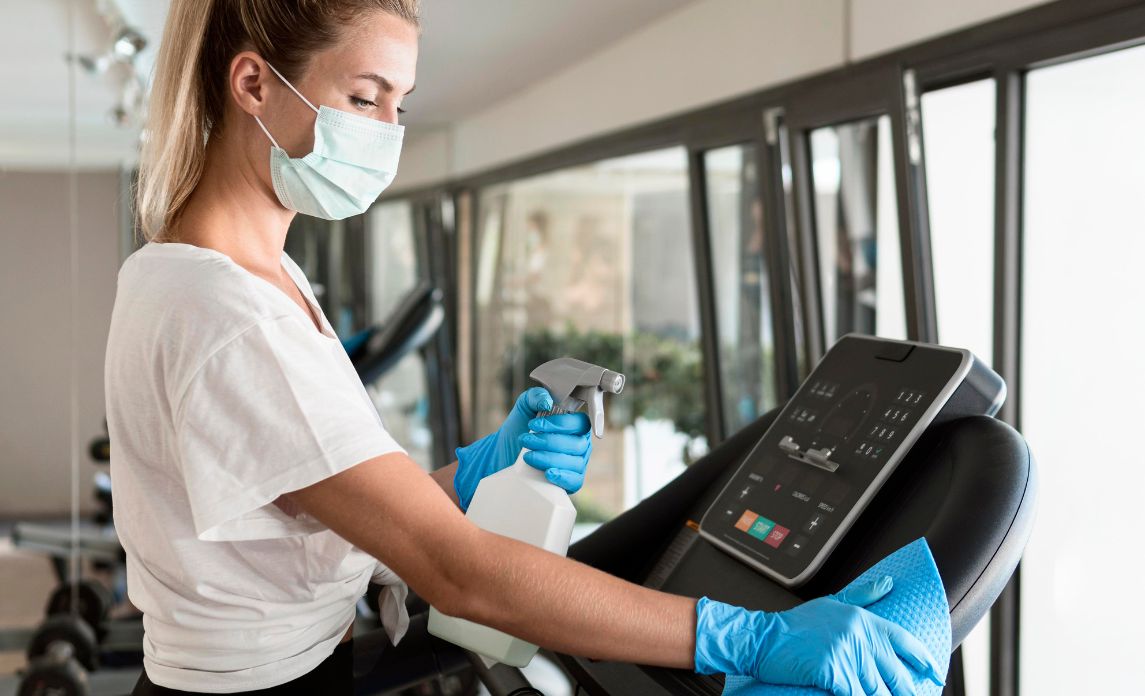Maintaining a clean and hygienic workout environment is important to the health and safety of gym-goers. The gym is a place where individuals strive for physical fitness and well-being, but it's also a setting where sweat, dirt, and bacteria can accumulate, particularly on shared equipment, potentially leading to health hazards.
Thus, regular cleaning of gym equipment is not only crucial for business but also a responsibility to ensure the well-being of everyone in the gym. For the best results, hire professional gym cleaners like Crewcare. With their combined expertise and equipment, you can rest assured that every corner and every piece of equipment are kept immaculate.
To highlight the significance of cleaning gym equipment, here’s a step-by-step guide that you can use as a reference:
The Gym Cleaning Checklist
Cleaning gym equipment properly starts with gathering the necessary supplies, which include but are not limited to:
- Disinfectant wipes or solution
- Clean, dry cloths or paper towels
- A set of cleaning brushes
- A bucket or spray bottle for the disinfectant solution
- Disposable gloves (optional)
That being said, different types of gym equipment may require slightly varying approaches to ensure thorough and safe cleaning without causing damage. Here’s a quick guide on how to clean common gym equipment:
Cardio Machines
Cardio equipment like treadmills, ellipticals, and stationary bikes may either be electric or self-powered. The former usually requires more care than the latter, but the most important thing to remember is to turn off and unplug the machine before cleaning.
Afterwards, remove any visible dirt, dust, and debris with a dry cloth or soft-bristle brush. Then, wipe down all surfaces, including handles, consoles, and displays with a cloth dampened with a disinfectant solution.
Be careful not to allow excess moisture to seep into electronic components, if there are any. For treadmill belts, avoid excessive moisture, as it can affect the lubrication. Use a separate cloth for this area.
Once everything is completely wiped down, let the machine to air dry completely before using it again.
Weightlifting Equipment
For weightlifting equipment like free weights and benches, sanitise them using the appropriate product. Remember not to put the disinfectant directly onto the equipment; rather, dampen a clean cloth with the product and use the cloth to wipe the surfaces.
Pay attention to areas where hands and bodies make contact, such as bench paddings, grips, and handles. If applicable, disassemble and clean any removable parts like bench cushions. Make sure everything is dry before reassembling and using.
Dumbbells and Barbells
The most important part about cleaning dumbbells and barbells is to disinfect the handles. For plastic- or vinyl-coated dumbbells, you can be more liberal with the use of disinfectant. For barbells and barbell plates, on the other hand, it’s crucial not to let moisture sit for long on the surfaces and crevices to prevent rust buildup.
Resistance Machines
Cleaning resistance machines is pretty straightforward. Simply wipe down the frame, handles, and padded areas with a cloth that’s slightly moistened with a disinfectant solution. Use a separate cloth or sponge to clean padded surfaces and avoid soaking them.
The most important thing is to be cautious around any pulley systems and moving parts to avoid accidents like getting your fingers pinched or nicked. Also, avoid spraying disinfectant directly on these areas, as the moisture might get into the nooks and crannies. Over time, this can result in corrosion and degradation of parts.
Yoga Mats and Floor Mats
In some aspects, yoga and floor mats are easier to clean because you can be less “careful” with them. That said, use a mild soap and a soft brush or sponge so as not to damage the material. Then, rinse the mats thoroughly and let them dry completely before use.
Rowing Machines and Spin Bikes
To clean rowing machines, spin bikes, and similar equipment, make sure to turn them off first. Then, dampen a cloth with a suitable disinfectant and then use this to wipe down the seat, handles, and frame. Include any display screens or electronics as well (but be mindful of the material so as not to inadvertently damage them).
As mentioned previously, be cautious around moving parts to prevent injuries. Finally, air dry the machine before using it again..
Resistance Bands and Stability Balls
For functional training equipment like resistance bands, stability balls, jump ropes, plyometric boxes, and the like, they can either be wiped down with a clean cloth or washed in warm, soapy water. Check the manufacturer’s instructions to be clear about the applicable cleaning methods.
Punching Bags
Punching bags are rather easy to clean using a cloth or sponge dampened with a disinfectant solution. Make sure that the disinfectant is suitable for the cover material; usually, punching bags have leather, vinyl, or nylon-based fabric covers. After wiping it down, allow the bag to air dry.
Once you’re done cleaning, throw away gloves, wipes, and other disposables properly. Lastly, thoroughly wash your hands with soap and water or use hand sanitizer to minimise the risk of contamination.
The Importance of Cleaning Gym Equipment
Maintaining the cleanliness of a gym is important for the following reasons:
- Health and hygiene. Gym equipment can harbour bacteria, viruses, and pathogens due to the sweat, oils, and skin cells left behind by users. These microorganisms can lead to the spread of infections and illnesses, such as skin conditions, allergies, and respiratory issues, among many others. Regular cleaning minimises this risk.
- Equipment Longevity. Improperly maintained gym equipment can wear down much faster. Through regular cleaning and maintenance, you can extend the equipment's life and save money on replacements.
- Odour Control. A gym that smells of stale sweat and body odour is not inviting. Proper cleaning eliminates these smells, creating a more pleasant workout atmosphere.
- User Satisfaction and Good Reputation. In relation to the previous point, a clean gym is more attractive to members, visitors, and would-be clients. People are more likely to continue using a gym that values cleanliness, resulting in higher customer retention rates.
- Regulatory Compliance. Health and safety regulations require gyms to maintain a certain level of cleanliness to operate legally. Neglecting cleaning practices could lead to regulatory fines or shutdowns.
In conclusion, cleaning gym equipment is not just a routine chore; it's a crucial element of maintaining a safe and inviting gym environment. A clean gym not only fosters better health but also contributes to the longevity and success of the facility. By hiring professional cleaners and regularly cleaning gym equipment, you can ensure the well-being of everyone who steps through the gym's doors and help them focus on their fitness goals with peace of mind.


